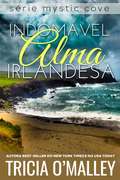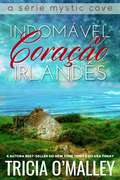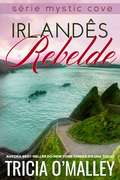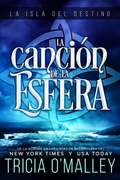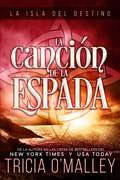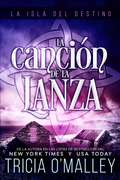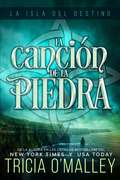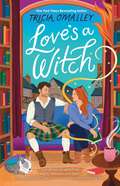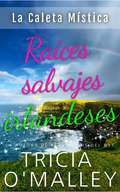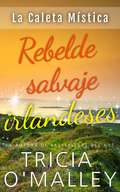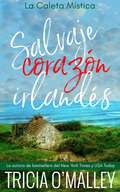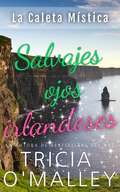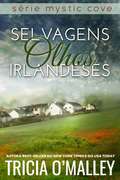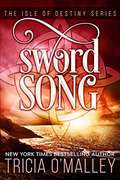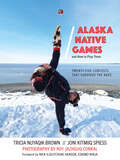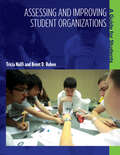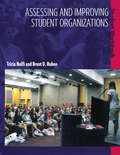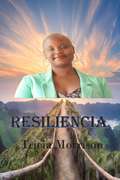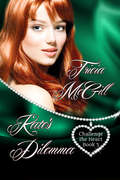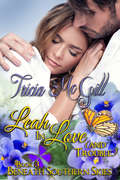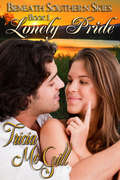- Table View
- List View
Indomável Alma Irlandesa (Mystic Cove #3)
by Tricia O'MalleyO terceiro livro da série Mystic Cove A autora best-seller do New York Times e do USA Today, Tricia O'Malley, nos traz uma série ambientada no escarpado litoral irlandês. O amor? Nunca foi o seu forte. Aislinn está acostumada a viver a vida de acordo com o que acha melhor. Sendo uma artista com um dom extra-sensorial, ela permite que seus humores, e os do mundo natural, inspirem as pinturas para a sua galeria de arte situada na pequena cidade de Grace’s Cove. Conduzindo os negócios do jeito que mais lhe agrada, Aislinn vem se esquivando de compromissos sérios durante toda a sua vida. Quando o Dr. Baird Delaney muda sua clínica psiquiátrica para a cidade e passa na loja de Aislinn para escolher algumas gravuras para o consultório, o mundo dela sofre um abalo. Sentindo uma irresistível atração à presença dele, e convencida de que um médico certinho seria uma péssima combinação para a sua alma livre de artista, ela se vê dividida. Tanto Aislinn quanto Baird terão que deixar de lado suas crenças à medida que caem de cabeça em um relacionamento obstinado e bagunçado que os desafia a aceitar um ao outro, sem reservas.
Indomável Coração Irlandês (Mystic Cove #1)
by Tricia O'MalleyA autora best-seller do New York Times e do USA Today, Tricia O'Malley, lança uma série de romances ambientada no escarpado litoral irlandês. Está na hora... Um livro antigo, um poder desconhecido e uma ânsia no coração, levam Keelin O’Brian da sua graduação em Boston até uma pequena vila litorânea no sul da Irlanda. Determinada a desvendar os segredos escondidos nas encantadas águas da enseada, Keelin tem pouco tempo para o irlandês intratável que a irrita durante o dia e assombra suas fantasias à noite. Inexplicavelmente atraído pela mulher que saiu de seus sonhos para a vida real, Flynn luta contra a crescente atração que sente por Keelin. Forças desconhecidas têm um plano para os dois. Somente os segredos da enseada podem mostrar a Keelin quem ela realmente é, a beleza do seu misterioso poder, e um amor capaz de romper os limites do que ela conhece. A série Mystic Cove: Livro 1: Indomável Coração Irlandês Livro 2: Selvagens Olhos Irlandeses Livro 3: Indomável Alma Irlandesa Livro 4: Irlandês Rebelde Livro 5: Indomáveis Raízes Irlandesas Livro 6: Indomável Bruxa Irlandesa Livro 7: Selvagem Bênção Irlandesa
Irlandês Rebelde (Mystic Cove #4)
by Tricia O'MalleyO quarto livro da série Mystic Cove A autora best-seller do New York Times e do USA Today, Tricia O'Malley, nos traz uma série ambientada no escarpado litoral irlandês. Uma solitária de corpo e alma… Morgan McKenzie se vira sozinha desde os dezesseis anos, quando fugiu de uma casa adotiva digna de pesadelos. Com medo de voltar a fincar raízes e acabar sendo magoada, Morgan prefere estar sempre se mudando. Até que ela se vê inexplicavelmente atraída para Grace’s Cove, uma cidadezinha do litoral irlandês. Antes que perceba, Morgan está com endereço fixo e fazendo amizades pela primeira vez na vida. Determinada a manter as defesas erguidas para proteger tanto o coração quanto o toque de mágica que carrega, Morgan luta contra sua crescente atração pelo queridinho da cidade, Patrick Kearney. Patrick não consegue tirar os olhos de Morgan. Desde o momento que cruzou com ela na pista de dança no casamento de Keelin, ele ficou perdido. Atraído pela beleza e pela vulnerabilidade dela, a frustração de Patrick só aumenta enquanto seus avanços continuam sendo rejeitados. Quanto mais Morgan se rebela contra o que sente por Patrick, mais ela é arrastada em uma batalha contra os seus piores demônios.
La Canción de la Esfera: Libro 4 de la Serie La Isla del Destino (La Isla del Destino #4)
by Tricia O'MalleyLa dramática y conmovedora conclusión de la serie La Isla del Destino. Neala O'Riordan no es ajena a las cosas dulces y picantes de la vida, aunque eso tiene más que ver con dirigir una pastelería muy aclamada en Kilkenny que en tener algún noviazgo en su vida. En lugar de meterse en enredos románticos, Neala vierte su amor y atención en su próspero negocio y los demandados pasteles que prepara. Cuando un hombre angustiado irrumpe en su panadería una mañana, la vida de Neala se pone patas arriba. En unos momentos, queda sumergida en un mundo de cuento de hadas, y ella es la estrella del espectáculo. Cuando se entera de que el destino de Irlanda, si no del mundo entero, descansa sobre sus hombros, Neala está lista para dar media vuelta y correr hacia las colinas, pero se detiene en seco por la tormenta que ve en los ojos de su atractivo protector. Dagda Con una mirada, Dagda desafía a Neala a quedarse y luchar, a aceptar su destino, y a cambiar el curso del futuro. Incapaz de resistir un desafío, Neala acepta y se une a un extraño grupo de humanos con poderes mágicos y faes por igual cuando se ve atrapada en la aventura de su vida. Es una carrera contrarreloj para poner fin a una maldición centenaria, y Neala hace todo lo posible para evitar que su corazón se enamore de los silenciosos encantos de su seductor protector. Aunque su batalla para resistir su atracción por Dagda puede ser una causa perdida, Neala se niega a perder la lucha contra los faes oscuros. Con la ayuda de sus amigos de Grace’s Cove, Neala se aferra a su creencia de que, pase lo que pase, el amor siempre iluminará el camino contra la oscuridad.
La Canción de la Espada: Serie: La Isla del Destino nº 2 (La Isla del Destino #2)
by Tricia O'MalleyDe la autora de best sellers del New York Times y el USA Today, Tricia O'Malley, llega una mágica y fascinante novela romántica ambientada en el Dublín moderno. Sasha Flanagan vive su vida al filo de la espada, literalmente. Como coleccionista y comerciante de espadas antiguas y esgrimista experta, ha pasado gran parte de su vida persiguiendo su objetivo de poseer una de las galerías de armas más prestigiosas del mundo. Los fae asesinos que salen de los callejones oscuros ciertamente no forman parte de sus cuidadosamente diseñados planes de vida. Sasha se encuentra rápidamente atrapada en una maldición de siglos de antigüedad, en la cual, para su sorpresa, tiene el papel principal. La tarea de encontrar una espada mitológica acompañada por una alegre banda de seres mágicos sacude su comprensión del mundo tal como ella lo conoce. La distracción adicional de un protector devastadoramente guapo, Declan, es lo último que Sasha quiere o necesita. Declan ha seguido a Sasha desde que ambos eran niños. Él ha crecido con ella, observándola silenciosamente en cada movimiento, le dolía el corazón cuando le dolía el suyo y su orgullo se hinchaba por sus logros. Ya sea que Sasha desee su ayuda o no, Declan morirá antes de verla perjudicada. A medida que el reloj se agota en su búsqueda, Sasha no está segura de que es lo que corre mayor peligro: su corazón o su vida.
La Canción de la Lanza: Libro 3 de la serie La Isla del Destino (La Isla del Destino #3)
by Tricia O'MalleyPerpetuamente alegre, Gwenith Donovan está contenta con la vida. Es dueña de una tienda de novedades que ama, charla todos los días con su gato gordinflón, Macgregor, y mantiene una meticulosa colección de cómics que hace que su corazón de geek se vuelva loco. No tiene necesidad o interés alguno en algún romance que pueda alterar su feliz rutina. A Gwen le basta con pasar sus días administrando su tienda y sus noches tomando una pinta con amigos en el pub del pueblo. Hasta el momento en que todo cambia, cuando Gwen descubre que podría estar viviendo en su propia fantasía mágica. Como el gran hechicero que es, Lochlain Laird no está acostumbrado a recibir órdenes, pero ni siquiera él puede desobedecer a la Diosa Danu cuando ella lo castiga por tomar una decisión que cambiará su vida. Danu obliga a Loch a abandonar el reino fae para proteger a una mujer distraída en una búsqueda. Sintiendo que es una tarea que no está a su altura, Loch permanece hosco mientras hace todo lo posible por evitar que su protegida sea asesinada por los malvados Domnua, a la vez que trata de ignorar sus encantos inesperados. A medida que la tensión aumenta en su viaje para romper una maldición de siglos, Loch debe aprender a dejar de lado su ego y Gwen debe confiar en sus propios poderes antes de que todo por lo que luchan se pierda para siempre.
La Canción de la Piedra (Serie: La Isla del Destino #1)
by Tricia O'MalleyDe la autora de best sellers del New York Times y el USA Today, Tricia O'Malley, llega una mágica y fascinante novela romántica ambientada en el Dublín moderno. Clare MacBride ha establecido su vida exactamente como ella la quiere. En un año, habrá terminado su tesis de geología, aunque no ha podido averiguar la respuesta a una pregunta que la atormenta. ¿Por qué puede sentir las pulsaciones de energía provenientes de las piedras? Una maldición de siglos de antigüedad, una misteriosa cofradía de protectores y una piedra divina mitológica, todo suena como un cuento de hadas del viejo mundo para Clare. Solo fue necesaria una noche lluviosa con un fae de ojos plateados y un apuesto extraño que asegura ser su protector para que su mundo sea sacudido para siempre. Con sus planes de vida destrozados, las líneas de la ciencia y la ficción se desdibujan cuando Clare se ve obligada a tirar por la ventana todo lo que sabe sobre el mundo y mirar dentro de su corazón en busca de respuestas.
Love's a Witch: A Cozy Fantasy Romance (The Scottish Charms Series)
by Tricia O'MalleyFrom New York Times bestselling author Tricia O&’Malley, Charmed meets The Pumpkin Spice Café in this cozy romantasy about a witch returning to Scotland to break a family curse—only to clash with one grumpy Scotsman determined to protect his town from her haywire magic.She&’s hexed. He&’s vexed. And for Scotland&’s most magical small-town, their feud might just spell disaster. Sloane MacGregor swore she&’d never return to Briarhaven, but with her twenty-fifth birthday looming—the day witches come into their magic—her grandmother summons her and her sisters back for one tiny task: break the centuries-old curse haunting their bloodline. Knox Douglas, Briarhaven&’s grumpy mayor, has worked tirelessly to make his town a haven for magical folk. The last thing he needs is a cursed MacGregor wreaking havoc. It doesn&’t matter he once crushed on her. For the sake of Briarhaven, Sloane has to go. But magic has other plans—and in Briarhaven, love really is a witch.
Love's a Witch: Charmed meets The Pumpkin Spice Café – an unmissable cosy witchy romance from the bestselling author of Wild Scottish Knight (The Scottish Charms Series)
by Tricia O'MalleyFrom the international bestselling author, Charmed meets The Pumpkin Spice Café in this cosy bewitching romance.'Steamy men in kilts, lightning-quick banter and ancient curses – this is pure dopamine!' ELIZABETH HUNTER'Love&’s a Witch is everything you want from a witchy romance and more' SARAH BETH DURST'A magical world of witches, romance and sisterhood' HELENA HUNTINGShe&’s hexed. He&’s vexed. And for Scotland&’s most magical small-town, their feud might just spell disaster.Sloane MacGregor swore she&’d never return to Briarhaven, but with her twenty-fifth birthday looming – the day witches come into their magic – her grandmother summons her and her sisters back for one tiny task: break the centuries-old curse haunting their bloodline.Knox Douglas, Briarhaven&’s grumpy mayor, has worked tirelessly to make his town a haven for magical folk. The last thing he needs is a cursed MacGregor wreaking havoc. It doesn&’t matter he once crushed on her. For the sake of Briarhaven, Sloane has to go.But magic has other plans – and in Briarhaven, love really is a witch.
Raíces Salvajes Irlandesas (La caleta mística #5)
by Tricia O'Malley"El camino más largo es el camino más corto a casa". - Proverbio irlandés Admitir errores no es fácil. Y para la testaruda Margret O'Brien, es prácticamente inaudito. Cuando Margaret regresa a Irlanda para la boda de su hija, se ve obligada a enfrentar su pasado. Simplemente no esperaba estar haciéndolo echada sobre el hombro de un irlandés increíblemente guapo y excepcionalmente enojado. Sin embargo, Sean Burke todavía puede hacer que los dedos de sus pies se doblen de lujuria. Veintiocho años, dos países y años de dolor se interponen entre la oportunidad de amor de Sean y Margaret.
Rebelde Salvaje Irlandesa: Libro 4 de La Caleta Mística (Libro 4 de La Caleta Mística #4)
by Tricia O'MalleyUna solitaria de corazón... Morgan McKenzie ha estado sola desde que huyó de una casa de acogida de pesadilla a la edad de dieciséis años. Temerosa de echar raíces de nuevo solo para ser lastimada una vez más, Morgan prefiere estar constantemente en movimiento. Hasta que la atrae inexplicablemente la pequeña ciudad irlandesa de Grace's Cove. Antes de que se dé cuenta, Morgan se está estableciendo y formando relaciones por primera vez en su vida. Decidida a mantener sus muros en alto para proteger tanto su corazón como el toque de magia que lleva, Morgan lucha contra su creciente atracción por el chico dorado de la ciudad, Patrick Kearney. Patrick no puede apartar la vista de Morgan. Desde el momento en que vio a Morgan al otro lado de la pista de baile en la boda de Keelin, Patrick ha estado perdido. Atraído por su belleza y vulnerabilidad, la frustración de Patrick crece a medida que sus avances son rechazados continuamente. Mientras Morgan se rebela contra sus sentimientos por Patrick, es arrastrada a una batalla contra sus propios peores demonios.
Salvaje corazón irlandés (La caleta mística #1)
by Tricia O'MalleyDe la autora de bestsellers del New York Times y USA Today, Tricia O’Malley, llega una serie romántica ambientada en las costas rocosas de Irlanda. Ya es hora… Un libro antiguo, un poder intacto y un corazón no amado llevan a Keelin O’Brien desde sus estudios de posgrado en Boston hasta un pequeño pueblo en la costa de Irlanda del Sur. Decidida a desterrar los secretos que esconden las aguas encantadas de la caleta, Keelin tiene poco tiempo para un irlandés malhumorado que la enfurece durante el día y hechiza sus fantasías de noche. Atraído de manera inexplicable por la mujer que se mete en sus sueños y en su mundo, Flynn lucha una batalla tenaz contra la creciente atracción por Keelin. Fuerzas desconocidas tienen mejores planes para los dos. Solo los secretos de la caleta pueden mostrarle a Keelin quién es ella en realidad, la belleza de su misterioso poder y un amor que romperá los límites de lo que ella conoce.
Salvajes ojos irlandeses (Serie La Caleta Mística. Libro 2 #2)
by Tricia O'MalleyOh, si pudiera callar las voces dentro de su cabeza. En realidad, las voces de los demás. Como dueña de un pub con un don extra especial, todo lo que Cait anhelaba era un momento de silencio. Eso y ser la propietaria del edificio donde funciona el pub y del corazón del propietario del edificio: Shane MacAuliffe. Aunque siente una atracción irresistible por Shane, sus propias vulnerabilidades la obligan a mostrarse dura. Cuando esas dos cabezas chocan, vuelan más que chispas y Cait se encuentra temblando al borde del precipicio del amor. Shane ha observado a Cait durante años. Obstinada, hermosa y atractiva; se muere por ponerle las manos encima. Cait es para él. Y, sin embargo, consigue enfurecerlo al escapar de sus besos. Todo el tiempo. Desesperado, Shane no sabe qué hacer para ganarse a Cait. Sin remordimientos y con un orgullo vehemente, Cait debe conquistar sus inseguridades y mostrarse ante Shane tal cual es o enfrentarse a perderlo todo.
Selvagens Olhos Irlandeses (Livro 2 da Série Mystic Cove #2)
by Tricia O'MalleyOh, essas vozes na sua cabeça podiam muito bem calar a boca. Bem, as vozes de outras pessoas. Cait Gallagher é dona de um pub e de um dom extra especial, mas tudo o que ela deseja é um momento de silêncio. E também ser dona do prédio onde o seu pub está localizado e mais: conquistar o coração do senhorio, Shane MacAuliffe. Embora esteja muito atraída por Shane, ela disfarçou suas vulnerabilidades com uma casca bem grossa. Quando os dois cabeça-dura ficam cara a cara, as coisas esquentam, e Cait se encontra tremendo à beira do precipício do amor. Faz anos que Shane está de olho em Cait. Teimosa, linda e com um corpo onde ele está louco para colocar as mãos. Cait é tudo para ele, e, ainda assim, ela continua enfurecendo-o ao se esquivar dos seus carinhos. Todas as vezes. À medida que a sua paciência vai acabando, Shane fica sem saber o que mais pode fazer para conquistar Cait. Obstinada e ferozmente orgulhosa, Cait precisa superar as próprias inseguranças e revelar seu verdadeiro eu para Shane… ou então terá que encarar a possibilidade de perder tudo pelo que lutou.
Sword Song (The Isle of Destiny)
by Tricia O'MalleyFrom New York Times and USA Today bestselling author, Tricia O'Malley, comes a captivating romance series set on the rocky shores of Ireland. <p><p> Sasha Flanagan lives her life by the sword – quite literally. As a collector and dealer of antique blades and an expert swordswoman, she’s spent much of her life single-mindedly pursuing her goal to own one of the most elite weaponry galleries in the world. <p> Murdering fae popping out of dark alleys are certainly not part of her carefully designed life plans. <p> Sasha quickly finds herself drawn into a centuries-old curse – in which, to her surprise – she holds the leading role. Tasked with finding a mythological sword while accompanied by a rag-tag band of magickal beings shakes her understanding of the world as she knows it. The added distraction of a devastatingly handsome protector, Declan, is the last thing Sasha wants or needs. <p> Declan has shadowed Sasha since they were both but wee children. He has grown up with her – silently watching her every move – his heart aching when hers ached and his pride swelling at her accomplishments. Whether Sasha wants his help or not, Declan will die before he sees her harmed. As the clock runs out on their quest, Sasha isn’t sure which is in greater danger: her heart or her life.
Alaska Native Games and How to Play Them (Snowy Owl)
by Tricia Nuyaqik Brown Joni Kitmiiq SpiessThe athletes of the Alaska Native games aren’t just returning to their roots. They’ve never left them. In this beautifully illustrated book, readers learn the history of twenty-five Native games that have been handed down through generations, how each one relates to the subsistence lifestyle, and how you can try them yourself, regardless of where you live. As Tricia Nuyaqik Brown shows, even though today’s competitions are a big media event in Alaska, the games themselves are really no different from those of long ago. Ancestral communities once pitted their strongest, their most agile, their fastest men and women against those from neighboring villages or tribal groups. Those games never died, but rather than gathering in a sod meeting place, competitions are now held in gyms and arenas. Each game today can be linked to some aspect of surviving in a harsh environment, of drawing sustenance from the land and sea. From the Seal Hop to the Bench Reach to the Four-Man Carry, these ancient games still require athletes to be in top physical condition and possess sharp mental focus. They hold dear the traditional Native values of honoring the elders, responsibility to tribe, sportsmanship, humor, patience, and hunter success. This book offers an engaging introduction to these games and their history, inviting people to jump in and try them for themselves!
Assessing and Improving Student Organizations: A Guide for Students (Higher Education Ser.)
by Brent D. Ruben Tricia NolfiThis Assessing and Improving Student Organization (AISO) program is intended as a guide for leaders of student-led college organizations. It is designed to promote the assessment of their organization by leaders and members, help them with planning and improvement, and assist them in responding to reviews by governing bodies and national chapters. Apart from affording their members a structure for engaging with peers in activities of mutual interest, collegiate organizations provide them with hands-on opportunities for enhancing understanding of groups and organizations, and how they operate, and for acquiring and practicing the leadership, communication and collaborative skills that are so important for personal and professional effectiveness throughout life. This Guide provides you with a structure for analyzing the workings of your organization. It will generate insights to help you determine how effectively the organization is functioning, identify strengths and weaknesses, devise priorities and plans for future improvement, and in the process, promote your reflective learning.The AISO process constitutes an ideal laboratory to practice and refine your capabilities for analyzing and improving groups and organizations.Purpose and Elements of the AISO ProgramThe Assessing and Improving Student Organization (AISO) program is intended as a guide for leaders of student-led college organizations. It is designed to promote the assessment of student organizations by their leaders and their members, to help them with planning and improvement, and assist them in responding to reviews by governing bodies and national chapters. Apart from affording their members a structure for engaging with peers in activities of mutual interest, collegiate organizations provide them with hands-on opportunities for enhancing understanding of groups and organizations, and how they operate, and for acquiring and practicing the leadership, communication and collaborative skills that are so important for personal and professional effectiveness throughout life.In addition, the AISO leadership process – unlike comparable programs – provides students with immediate and authentic feedback to evaluate their leadership, and how they impact their organization, community, and campus. The program consists of three elements: a Guide for Students, a Student Workbook, and a CD-ROM for facilitators.AISO has been developed under the auspices of NACA and ACPA by two authors who are experts in organizational and leadership development, student affairs, and human resources management.This is a unique, easy to use, and effective process that reflects input from student leaders.An ACPA Publication
Assessing and Improving Student Organizations: Student Workbook
by Brent D. Ruben Tricia NolfiThis Assessing and Improving Student Organization (AISO) program is intended as a guide for leaders of student-led college organizations. It is designed to promote the assessment of their organization by leaders and members, help them with planning and improvement, and assist them in responding to reviews by governing bodies and national chapters. Apart from affording their members a structure for engaging with peers in activities of mutual interest, collegiate organizations provide them with hands-on opportunities for enhancing understanding of groups and organizations, and how they operate, and for acquiring and practicing the leadership, communication and collaborative skills that are so important for personal and professional effectiveness throughout life. This Guide provides you with a structure for analyzing the workings of your organization. It will generate insights to help you determine how effectively the organization is functioning, identify strengths and weaknesses, devise priorities and plans for future improvement, and in the process, promote your reflective learning.The AISO process constitutes an ideal laboratory to practice and refine your capabilities for analyzing and improving groups and organizations.Purpose and Elements of the AISO ProgramThe Assessing and Improving Student Organization (AISO) program is intended as a guide for leaders of student-led college organizations. It is designed to promote the assessment of student organizations by their leaders and their members, to help them with planning and improvement, and assist them in responding to reviews by governing bodies and national chapters. Apart from affording their members a structure for engaging with peers in activities of mutual interest, collegiate organizations provide them with hands-on opportunities for enhancing understanding of groups and organizations, and how they operate, and for acquiring and practicing the leadership, communication and collaborative skills that are so important for personal and professional effectiveness throughout life.In addition, the AISO leadership process – unlike comparable programs – provides students with immediate and authentic feedback to evaluate their leadership, and how they impact their organization, community, and campus. The program consists of three elements: a Guide for Students, a Student Workbook, and a CD-ROM for facilitators.AISO has been developed under the auspices of NACA and ACPA by two authors who are experts in organizational and leadership development, student affairs, and human resources management.This is a unique, easy to use, and effective process that reflects input from student leaders.An ACPA Publication
Resiliencia
by Tricia MorrisonPrefacio En diciembre de 2017, me quedé oficialmente desempleado, así que decidí que haría enseñanza de inglés independiente a tiempo parcial. Esto significaba automáticamente que dependería del Sistema de Asistencia Social del Gobierno alemán para sobrevivir, ya que no ganaría suficiente dinero para vivir. Esta situación causó que muchas emociones me envolvieran, pero la más dominante de estas emociones fue un sentimiento de atrapamiento, ya que me había declarado independiente del sistema de ayuda social dos años antes. Por lo tanto, sentí que mi vida retrocedía en lugar de progresar. Esta situación me obligó a cuestionar el núcleo de mi existencia. ¿Por qué me fui de Jamaica? ¿Por qué he estudiado durante tantos años? ¿Por qué creo en Dios? ¿Cuál es el propósito de mi vida? La verdad es que me sentí frustrado, enojado y enojado. Siempre he sido un "buen deporte", un ciudadano modelo en Jamaica, un buen inmigrante en Berlín, un gran trabajador, libre de drogas, libre de enfermedades, útil, esperanzado, además de un miembro activo y colaborador de mi comunidad y sociedad. Para colmo, he hecho todo lo que el sistema alemán requiere para que una persona se convierta en un miembro integrado de la sociedad. Entonces, ¿qué estaba pasando y por qué me sentí atrapado? Una cosa era segura; No podía permanecer en un estado de frustración e ira. Esto eventualmente habría llevado a un montón de otras emociones negativas y quejas, que definitivamente no traerían ayuda ni me impulsarían. Así que tuve que sacarme de ese estado.
Resilienza
by Tricia MorrisonHo scritto delle esperienze della mia colorata infanzia e del mio viaggio di vita, da quando sono crescita nei ghetti della Giamaica fino a un bizzarro asilo in Polonia fino ancora alle belle esperienze vissute a Berlino, per potervi descrivere la resilienza. Ho utilizzato quello che ho imparato con l'istruzione e dalla vita per dare uno sguardo a come le mie esperienze passate mi hanno formata e mi hanno reso resiliente. In ciascun capitolo mi soffermerò sulle lezioni che ho imparato e sui miei pensieri. Le lezioni forniscono al lettore modi utili per esercitare e trovare la resilienza nella propria vita, mentre i pensieri stimolano una riflessione profonda con cui il lettore avrà l’opportunità di sviluppare la propria opinione riguardo i fatti illustrati.
Jews and Anti-Judaism in Esther and the Church
by Tricia MillerThe biblical book of Esther records an account of Jewish resistance to attempted genocide in the setting of the Persian Empire. According to the text, Jews were targeted for annihilation simply because of their Jewish identity. However, the story also reports that they were allowed to defend themselves against anyone who sought to kill them. In the context of attempted genocide, the message of Esther addresses a timeless and universal issue of justice - that humans have the right and responsibility to defend themselves against those who intend to murder. 'Jews and Anti-Judaism in Esther and the Church' shows how the anti-Judaism that is a central feature of Esther relates to the contemporary issue of the contested legitimacy of the State of Israel as part of the ongoing Arab-Israeli conflict. In her outstanding book, Dr. Tricia Miller uses an academic approach to demonstrate the relationship of historic theology to current events concerning Israel for the purpose of encouraging Christians to support Israel's right to exist and defend itself against those who seek its destruction.
Trust in Experience: Transferable Learning for Primary Care Trusts
by Geoff Meads Tricia MeadsPrimary Care Trusts are a flagship initiative of government policy for modernising the NHS. The new requirement for frontline healthcare professionals to work together stretches across both community care and public health, and as a result traditional boundaries are being blurred and new local roles and resources are emerging right across the primary care sector. This book draws practical lessons for Primary Care Trusts from applied research and development programmes in other parts of the NHS, other parts of the public sector, parallel developments in the private sector and relevant international experience. With contributions from the Health Management Group and its associates, this book provides a comprehensive approach and practical guidance. It includes new specific models for local development on clinical governance, evidence-based medicine, use of applied health services research, social services collaboration, new organisational partnerships, public health alliances, community hospital usage and managed care. Trust in Experience will enable readers to create PCTs as their own organisations and not simply as local agents of central policy, and perceive changes as positive opportunities whilst recognising the risks involved.
Kate's Dilemma (Challenge The Heart #3)
by Tricia McgillWhat happens when two people who are both of the same mind—this being to steer well clear of emotional entanglements—are struck down by instant attraction. Kate last met Liam when she was bridesmaid at her sister’s wedding. A gangly, uncertain fourteen year old, going through the painful problems associated with growing up, she took an instant dislike to Liam, who made fun of her. When her recently widowed sister talks her into reluctantly accompanying her to her brother-in-law’s home, which was built by its owner, architect Liam, Kate falls in love with the house and, unfortunately for her, finds that she soon has corresponding feelings for the man who owns it. Meanwhile, Liam cannot believe that the tall, insecure teenager he met at his brother’s wedding years ago has blossomed into this beautiful, talented woman. His inbuilt antennae that had served him well, stood every chance of being annihilated if he didn’t watch out.
Leah in Love: Beneath Southern Skies (Beneath Southern Skies #3)
by Tricia McgillViolet Amelia Connor, known to all as Leah, is a landscape designer who inherited her love of gardening from the eccentric aunt she lives with. Leah is contracted to work on the garden of Private Investigator Sean Russel and unwittingly becomes embroiled in the handsome PI’s cases. A series of unpleasant experiences land her in real trouble where she is kidnapped, bashed, bound and altogether becomes a party to such mayhem she is forced to wonder how she ever got mixed up in this mess. But her indomitable spirit, obstinate nature, and incurable sense of humor enable her to override all obstacles. And of course there is her overwhelming attraction for Sean Russel that started it all.
Lonely Pride (Beneath Southern Skies #1)
by Tricia McgillSam fell in love with Mac at first sight when she was still a child and he a teenage boy, almost but not quite a man. A special bond formed between them, fueled by their mutual love of animals—especially horses. As each matured, that bond threatened to move beyond the limits of friendship. By the time Sam reached her 17th birthday she was desperately in love with him, her shining hero. But one awful night Mac betrayed that love and Sam was unable to find it in her heart to forgive him. By the time the truth was revealed they had both moved on with their lives, and Sam’s pride prevented her from forgiving Mac; threatened to ensure her a lonely future.
